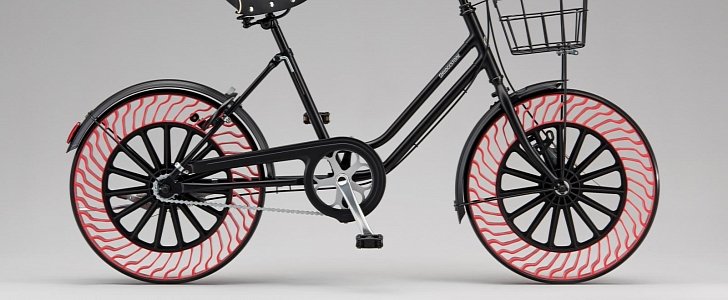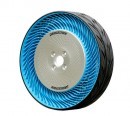Airless tires are not a new concept. The idea first came a few years ago, with some working prototypes actually being fitted to different vehicles, including military ones. However, Bridgestone decided to give the idea another try, thus releasing this new model specially built for bicycles.
Bridgestone Corporation along with Bridgestone Cycle Co., Ltd., recently announced a next-generation bicycle tire as an effort to realize practical application of the Air Free Concept. The two companies said they will continue with a feasibility study seeking to put it into production by 2019.
The “Air Free Concept” is a technology that eliminates the need for tires to be inflated with air to support the weight, using a unique structure of spokes stretching along the inner sides of tires. Also, the resins that are used in the spokes and rubbers help realize more efficient use of resources.
The company’s first non-pneumatic tire was shown back in 2013 at the Tokyo Motor Show, with the said concept being said to improve load-bearing capabilities, environmental design, and driving performance.
“With a unique structure of spokes stretching along the inner sides of the tires supporting the weight of the vehicle, there is no need to periodically refill the tires with air, meaning that the tires require less maintenance,” Bridgestone described the concept at the time. “At the same time, the worry of punctures is eliminated. In addition, the spoke structure is made from thermoplastic resin and, along with the rubber in the tread portion, the materials used in the tires are recyclable, contributing to the efficient use of resources.”
Furthermore, by offering low rolling resistance and contributing to reductions in CO2 emissions through the use of proprietary technologies, Bridgestone said it is possible to achieve even higher levels of environmental friendliness and safety. The company is pursuing this technological development with the aim of achieving a "cradle to cradle" process that proactively maximizes the cyclical use of resources from worn tires into new tires and the use of recyclable resources.
However, fast-forward to 2017, and we still don’t have mass-produced airless tires, meaning the good old 100-years-into-development regular inflatable tire is still the more feasible way to roll down the road.
The bicycle industry might be better suited to initially adopt this new technology since its lower production, and generally less stressful forces applied to the wheels compared to the automotive branch.
The “Air Free Concept” is a technology that eliminates the need for tires to be inflated with air to support the weight, using a unique structure of spokes stretching along the inner sides of tires. Also, the resins that are used in the spokes and rubbers help realize more efficient use of resources.
The company’s first non-pneumatic tire was shown back in 2013 at the Tokyo Motor Show, with the said concept being said to improve load-bearing capabilities, environmental design, and driving performance.
“With a unique structure of spokes stretching along the inner sides of the tires supporting the weight of the vehicle, there is no need to periodically refill the tires with air, meaning that the tires require less maintenance,” Bridgestone described the concept at the time. “At the same time, the worry of punctures is eliminated. In addition, the spoke structure is made from thermoplastic resin and, along with the rubber in the tread portion, the materials used in the tires are recyclable, contributing to the efficient use of resources.”
Furthermore, by offering low rolling resistance and contributing to reductions in CO2 emissions through the use of proprietary technologies, Bridgestone said it is possible to achieve even higher levels of environmental friendliness and safety. The company is pursuing this technological development with the aim of achieving a "cradle to cradle" process that proactively maximizes the cyclical use of resources from worn tires into new tires and the use of recyclable resources.
However, fast-forward to 2017, and we still don’t have mass-produced airless tires, meaning the good old 100-years-into-development regular inflatable tire is still the more feasible way to roll down the road.
The bicycle industry might be better suited to initially adopt this new technology since its lower production, and generally less stressful forces applied to the wheels compared to the automotive branch.




